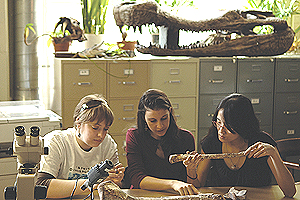Female students assisting with paleontological lab work help attract more women to study sciences
By Lien PayneNews Office
 Paul Sereno (above, right) and his laboratory staff members Caitlin Wylie (left to right), Stephanie Crofts, and Sara Burch study fossils. Below, Elena Schroeter (left to right), Hannah Moots and Nancy Chang do some collaborative research. Photos by Dan Dry.  | |
Through lab work and expeditions, University paleontologist Paul Sereno is introducing six female College students to fields dominated by men.
“The number of women in science is increasing, but the question is, why aren’t they getting into faculty positions at the rate that they’re getting into graduate programs?” asked Sereno, Professor in Organismal Biology & Anatomy. “One reason is a lack of female role models. That may explain why so many women are involved in my lab—because some of the female students working in the lab are in advisory and senior positions.”
Hannah Moots, Nancy Chang, Sara Burch, Caitlin Wylie, Stephanie Crofts and Elena Schroeter are the six College students and alumnae who, with funding help from the University Women’s Board, have been able to work with Sereno in his fossil lab and participate in expeditions to Africa and Asia. From 2005 to 2006, Sereno’s lab received one of 18 University Women’s Board grants that supported student groups, faculty and student research, community outreach and other projects.
“The Women’s Board is immensely pleased to have provided nearly $74,000 in funding in support of Paul Sereno’s work since 1996. These grants have supported a variety of endeavors, including the expeditions themselves and the cleaning and reconstruction of his team’s discoveries,” said Kate Benson, Chair of the University Women’s Board.
The grant in combination with Sereno’s work enabled students like Moots to fully realize careers in science. Moots was only looking for an elective as a first-year in the College when she took Sereno’s “Dinosaur Science” class, but after the class excavation trip to Wyoming, Moots started volunteering in Sereno’s lab, working on the fossil preparation team and joined an expedition to Niger. In part due to Moots’ experience, she now plans to become a professional archaeologist and teacher.
Chang, a College fourth-year, also became interested in paleontology two years ago in Sereno’s “Dinosaur Science” class. Another member of the fossil preparation team, Chang counts her work in his lab as part of the fun she has experienced while at Chicago.
“What drew me to the University was this great, nerdy, quirky image that just seemed so fun,” Chang said.
Other members of Sereno’s lab were interested in paleontology before even attending the University. Burch, a 2006 College graduate, took Sereno’s “Stones & Bones” summer class while in high school. Since then, she has become part of the fossil preparation team, traveled as a team member on Sereno’s paleontological expedition to Inner Mongolia, and has become a research assistant at the Field Museum. She plans to attend graduate school to study vertebrate paleontology and later teach and do research.
Like Burch, College third-year Wylie had actual excavation experience while still in high school on a trip to Wyoming and South Dakota as part of the “Stones & Bones” summer class.
“We did a lot of excavation. It was a wonderful, fantastic experience,” Wylie said of the trip. “When I came back to the lab as part of the preparation team, Sara taught me everything I knew. It’s very much a community here.”
Wylie is now interested in promoting science education as a means to increase women’s access to science.
“Professor Sereno’s proposals have received this unprecedented level of funding for a single faculty member in no small part because they have enabled students, particularly undergraduates, to gain invaluable first-hand research experience both in the field and in the University,” Benson said.
Currently the lab coordinator for fossil preparation and a teaching assistant, Crofts was able to participate in last year’s archaeological expedition to Niger. Crofts, who began her work in Sereno’s lab after taking his “Vertebrate Structure & Function” class, is a 2006 graduate and will be studying vertebrate function and evolution in graduate school this fall.
Schroeter, also of the Class of 2006, works not only in Sereno’s lab, but since high school has volunteered as a fund-raiser for Project Exploration, the nonprofit science education organization Sereno co-founded with University alumna Gabrielle Lyon.
“I’ve been interested in dinosaurs since I was 5 years old,” said Schroeter, who, later in school, said she found few opportunities to engage her interest. “Project Exploration gave me an opportunity to realize my goals.”
The campus-based organization Project Exploration works to make science more accessible to the public, especially to groups that are underrepresented in science, such as minority youth and women. Youth programs and exhibits provide students with opportunities to work with professional scientists and become engaged through hands-on experience.
Now the Youth Development Coordinator at Project Exploration, Schroeter considers her work with the organization a way for her to give back to a science community that has helped her pursue her interests.
“Whether they become scientists or not, they reach out to us and keep in contact with us,” Schroeter said of the students with whom she works. “We in turn are always offering them opportunities to pursue their scientific interests during the year.”
She plans to continue her work at Project Exploration for at least another year, before attending graduate school in paleontology.
“It is still a fact that the professional ranks are lopsided,” said Sereno, “and the chance to change that is really great.”
![[Chronicle]](/images/sidebar_header_oct06.gif)